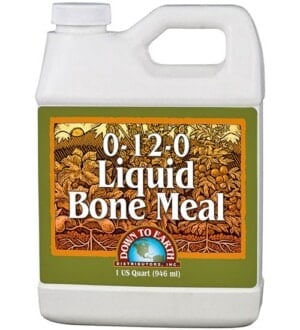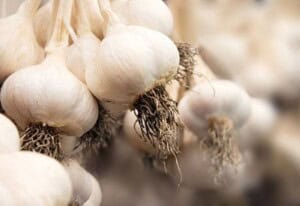Early to bed, early to rise, Work like hell: fertilize. – Emily Whaley
In a perfect world, your garden’s soil would provide all the nutrients and trace elements plants need. But in the real world, garden and lawn soil — and thus the plants that live in them — often needs a little boost.
Improving the health of your soil is the number one thing you can do to improve your garden, yard or landscape and organic fertilizers can help. They provide a wide array of macro and micronutrients, encourage lush growth and beautiful blooms and give long-lasting, healthy results year after year.

IT'S ORGANIC!
Alaska Fish (5-1-1)
An all-purpose, deodorized fish emulsion for use on all indoor and outdoor plants.
Learn morePlanet Natural carries a large variety of natural and organic fertilizers designed to encourage growth, blooms and bountiful harvests. Give them a try… your gardens will perform beyond your highest expectations!
All plants need:
- Macronutrients – nitrogen, phosphorus and potassium
- Secondary nutrients – sulfur, calcium and magnesium
- Micronutrients – iron, manganese, zinc, chlorine, boron, copper and nickel (in very small quantities)
Organic fertilizing can be as easy or as technical as you want it to be. For gardeners who don’t wish to spend a lot of time figuring out what individual plants want, there are commercial blends that can be used on all plants.
For those who like to treat each plant as an individual there are singular fertilizers or mixes for every kind of plant. Often fertilizing protocol changes as the plant grows. Keep reading to review the best fertilizing method for you.
Why Organic?
Plants can’t tell if the nitrogen, or other essential nutrients, they are taking up came from an organic or chemical source, but choosing an organic over chemical fertilizer does have an impact on the health of your vegetables, your soil and groundwater.
Organic fertilizers actually improve the soil, while chemical or synthetic fertilizers deplete the soil over the long run.
Organic Fertilizers
|
Chemical Fertilizers
|
Chemical fertilizers came about after WWII when the companies that made ammonia gas for explosives needed to find a way to stay in business. So, they figured out how to make ammonia gas (mostly nitrogen) into fertilizer.
Dry Organic Fertilizers
Dry fertilizers can be made from a single ingredient (such as greensand, blood meal or steamed bone meal) or a blend of nitrogen, potassium and phosphorus plus micronutrients. There are many commercial blends available or you can make your own. See our article Fertilizer Recipes: How to Make Your Own for some time-tested tips.

BIGGER BLOOMS
Bloom Booster (3-9-4)
Promotes MAXIMUM blooms and strong root development in flowering plants.
$13.50Learn moreIdeal for fruit trees and ALL flowering plants! Dr. Earth® Bud & Bloom Booster is a hand-crafted organic fertilizer used to promote MAXIMUM blooms and strong root development. Each 4 lb box feeds 80 one-gallon plants or 16 five-gallon plants.
Applying Dry Organic Fertilizers
- Before planting broadcast dry fertilizer across the soil.
- Rake or hoe fertilizer into the top 4-6 inches.
- Add small amounts to planting holes or rows.
- Side dress plants during the growing season.
Liquid Organic Fertilizers
Plants have the ability to absorb liquids through both their roots and their stomata (pores on the leaf’s surface). Liquid fertilizers can be applied to the soil or sprayed on to the leaves (see Foliar Fertilization – PDF).
Liquid fertilizers (whether a commercial blend, fish emulsion or compost tea) are especially beneficial during critical times in a plant’s life such as just after transplanting, during extreme temperatures or drought, or when the plant is blooming or setting fruit). Foliar fertilizing will also benefit plants throughout the growing season and can be applied every 2-4 weeks.
Applying Liquid Fertilizers
- Always follow label instructions.
- Using a surfactant (coconut oil or mild soap — 1/4 tsp per gallon of spray) to help get the best coverage.
- Check the spray’s pH — a slightly acidic fertilizer (6.0-6.5) is best (lower pH with vinegar).
- Use a spray mister with the finest mist possible.
- Spray until liquid drips off the leaves, being sure to spray the underside of leaves where pores are most likely to be open.
- Spray during the early morning or late evening for best absorption.
- OR water liquid fertilizers around the roots of plants.

HIGHLY CONCENTRATED
Bone Meal (0-12-0)
Bulbs and transplants get a little extra love from this easy-to-apply formulation.
$10.95Learn moreBulbs and transplants get a little extra love from Down to Earth® Liquid Bone Meal (0-12-0). Add this easy-to-apply formulation of phosphorus and calcium from micronized material to your daffodils, fruit trees and any other plants to get better root growth plus excellent bud and flower set. Apply as a soil drench or foliar spray.
Nutrient Supplements
Having little or no N-P-K of their own, nutrient supplements are designed to optimize fertilizers, not act as them. Containing vitamins, minerals, and hormones not found in most commercial plant foods, these give your plants “that little something extra.” The most well known is kelp which:
- contains at least 60 trace elements that plants need in very small quantities
- contains growth promoting enzymes and hormones
- stimulates soil bacteria (which increases fertility through humus formation, aeration and moisture retention)
Kelp is sold both as a dry meal and as a liquid concentrate.
Applying Nutrient Supplements
- Liquid supplements can be applied following the same method as liquid fertilizers.
- Kelp meal should be applied at 1-2 lbs per 100 square feet each spring. Kelp extract can be applied weekly to outdoor plants at a rate of 3 tablespoons per gallon of water.
- If you can find fresh seaweed, rinse the salt off and use it in the garden as mulch or throw it in the compost pile.
Types of Organic Fertilizers
Bird & Animal Manures: Good nutrient source and chock-full of microorganisms. Should be well-aged or composted before applying directly to the garden.
Blood Meal: Slow release source of nitrogen plus trace minerals. Apply just before planting and use sparingly.
Fish Meal/ Emulsion: Source of nitrogen, phosphorus, potassium and trace elements. Releases quickly.
Greensand: Rich in potassium and numerous micronutrients. Can be used to loosen clay soils. Apply 5-10 lbs per 100 square feet.
Shellfish Meal: Strong source of calcium (23%), nitrogen, phosphorus and micronutrients. May also be used to inhibit root-knot nematodes.
Rock Phosphate: Great for flowering plants and provides a 10 year phosphate reserve.
Once you figure out what you want from your fertilizer, it is easy to pick the right one.
Desired Effect |
Fertilizer |
| Promote large blooms and fruits | Bat guano |
| Condition soil | Compost Animal manures |
| Promote sturdy above-ground plant growth | Blood meal Fish emulsion |
| Promote root growth in transplants and seedlings | Phosphate rock Bone meal |
| Enhance composting process | Alfalfa meal Blood meal |
| Bind sandy soil | Colloidal rock phosphate |
| Loosen clay soil | Greensand Coconut coir |
Which Vegetables Need the Most Fertilizer?
Light Feeding Vegetables
Bean, beet, carrot, onion, pea, potato, radish, turnip
Heavy Feeding Vegetables
Broccoli, Brussel sprouts, cabbage, cauliflower, celery, corn, cucumber, kale, leeks, lettuce, melon, peppers, pumpkin, spinach, squash, tomato
Biological Approaches that Promote Plant Health
Mycorrhizae are beneficial soil organisms that are probably already growing in your soil. They form a symbiotic relationship with plant roots. Mycorrhizal fungi benefit plants by:
- Colonizing plant roots and sending hyphae throughout the soil, essentially extending the plant’s reach.
- Blocking disease organisms.
- Absorbing phosphorous, water and trace minerals — and sharing them with the plant.
- Excreting sticky compounds that bind the soil into aggregates, keeping the soil porous and airy.

OMRI LISTED
Plant Success (3-1-2)
A mixture of beneficial fungi that are well suited to a wide variety of soils and plants.
$19.95Learn moreWorms improve the soil in many ways:
- Improve the structure of the soil (aerating clay soils and binding sandy soils together).
- Burrowing opens channels for root growth.
- They help regulate water (moving moisture to dry areas and draining water clogged areas).
- Chomping up leaves and other organic debris.
- Worms leave behind castings full of nutrients.
It’s not just the worms that are good for your garden, their nutrient-rich castings (basically worm poop) are an excellent soil additive. Castings can be produced commercially, or you can raise worms yourself. Read our article Composting with Worms to learn how.
There are a lot of ways to reap the benefits of worm castings, including:
- Top Dressing: Spread a layer (1/2 inch deep) of castings around plants. Mulch and water.
- Seed Starting Mix: 3 parts aged compost or coconut coir to 1 part castings.
- Potting Mix: 2 parts aged compost, 1 part castings, 1/2 part vermiculite.
- Trees and Fruit Trees: Apply around the base and water well. Reapply when necessary.












